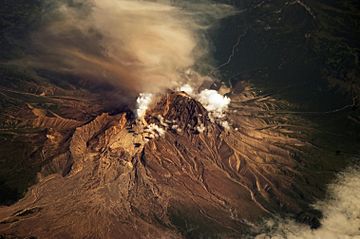Shiveluch facts for kids
Quick facts for kids Shiveluch |
|
|---|---|

Shiveluch from space, July 2007.
|
|
| Highest point | |
| Elevation | 3,283 m (10,771 ft) |
| Prominence | 3,168 m (10,394 ft) Ranked 73rd |
| Listing | Ultra |
| Geography | |
| Location | Kamchatka, Russia |
| Parent range | Eastern Range |
| Geology | |
| Age of rock | late Pleistocene |
| Mountain type | Stratovolcano (active) |
| Last eruption | 1999 to 2022 (ongoing, non-stop) |
| Climbing | |
| Easiest route | basic rock/snow climb |
Shiveluch (Russian: Шивелуч), also called Sheveluch, which originates from the name "suelich" which means "smoking mountain" in Itelmen is the northernmost active volcano in Kamchatka Krai, Russia. It and Karymsky are Kamchatka's largest, most active and most continuously erupting volcanoes, as well as one of the most active on the planet. Shiveluch erupts around 0.015 cubic kilometers (0.0036 cu mi) of magma per year, which causes frequent and large hot avalanches and lava dome formations at the summit. Ash emissions from this volcano often disrupt air traffic connecting the Asian and North American continents.
Geography
Shiveluch belongs to the Kliuchevskaya volcano group, located in central Kamchatka 84 kilometers (52 mi) northwest of Ust-Kamchatsk. The nearest settlement from the volcano is Klyuchi, situated 50 kilometers (31 mi) from the mountain. The settlement is small enough to evacuate rapidly in case of a major eruption.
Geologic setting
Shiveluch is a volcano within the Kuril–Kamchatka volcanic arc which hosts tens of other volcanoes. As the Pacific Plate crust subducts deeper under the Okhotsk Plate, the boiling points of minerals underground are reduced by other materials including water which results in the materials melting and forming into magma which rises onto the surface and forms the volcanoes.
Structure
There are three elements of the volcano: the stratovolcano Old Shiveluch (Старый Шивелуч); an ancient caldera; and the active Young Shiveluch (Молодой Шивелуч), with an elevation of about 2,800 meters (9,200 ft). Shiveluch is one of Kamchatka's largest and most active volcanic structures. It is a stratovolcano composed of alternating layers of solidified ash, hardened lava and volcanic rocks.
Geologic history
Shiveluch began forming about 60,000 to 70,000 years ago, and it has had at least 60 large eruptions during the Holocene. During this era, the most intense period of volcanism — including frequent large and moderate eruptions — occurred around 6500–6400 BC, 2250–2000 BC, and AD 50–650. This coincides with the peak of activity in other Kamchatka volcanoes. The current active period started around 900 BC. Since then, the large and moderate eruptions have been following each other at 50-to-400-year-long intervals. Catastrophic eruptions took place in 1854 and 1957, when a large part of the lava dome collapsed and created a devastating debris avalanche.
The most recent eruption of Young Shiveluch started on 15 August 1999, and continues as of 2021[update]. On 27 February 2015, Shiveluch erupted ash into the atmosphere about 9,100 meters (30,000 ft) crossing the Bering Sea and into Alaska.
On 11 April 2023, Shiveluch suffered an eruption once again.
Gallery
-
The heat signature of a pyroclastic flow on Shiveluch in January 2011
See also
 In Spanish: Shiveluch para niños
In Spanish: Shiveluch para niños











